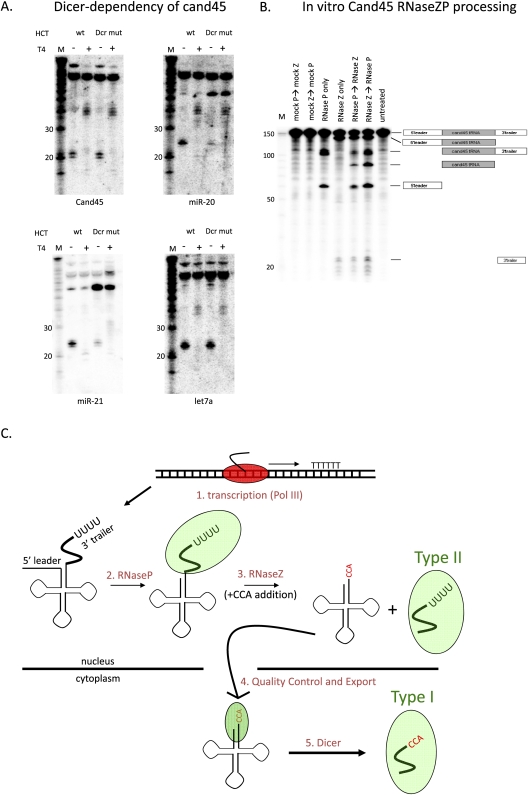FIGURE 2.
RNaseZ-dependent, Dicer-independent cand45 biogenesis. (A) Cand45 expression is unchanged in a HCT116-derived cell line that contains a mutation in the Dicer helicase domain. Most (e.g., miR-20 and miR-21), but not all (e.g., let-7a) microRNAs are down-regulated in this cell line. wt: Parental HCT Dicer wild-type cell line; Dcr mut: HCT-derived Dicer helicase mutant cell line; T4: test for T4 RNA ligase sensitivity (−: untreated; +: treated). (B) In vitro RNaseZ/P processing of cand45 tRNA. A radioactively labeled, in vitro transcribed cand45 precursor tRNA was treated with buffer alone (“mock”), recombinant human RNaseZ and/or purified human RNaseP. Arrows indicate that RNA was treated sequentially with stated conditions. Reaction products (schematic for predicted fragments shown on the right) were visualized on a polyacrylamide gel. M: Decade (Ambion) RNA size marker. (C) Model for tsRNA biogenesis: RNA polymerase III (Pol III) generates a precursor tRNA (1). The 5′ leader and 3′ trailers are removed by RNaseP (2) and Z (3), respectively. The mature tRNA is then exported into the cytoplasm (4). There, Dicer recognizes some, potentially misfolded tRNAs to produce Type I tsRNAs (5). The small RNA produced by nuclear RNaseZ cleavage and Pol III termination is a Type II tsRNA. Based on the near-exclusive cytoplasmic localization of type II tsRNAs, it is possible that a cytoplasmic pool of RNaseZ is responsible for the processing into type II tsRNAs of immature tRNAs have evaded nuclear quality control (data not shown).

